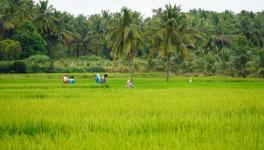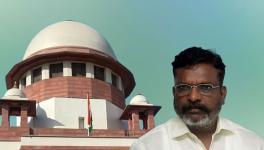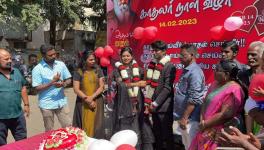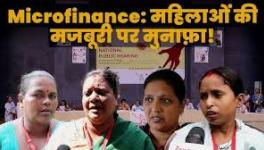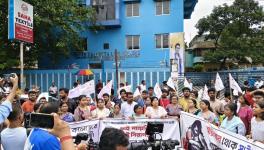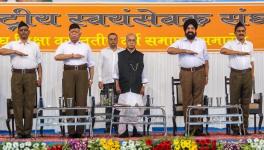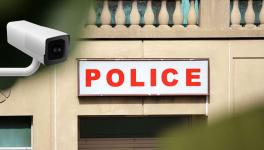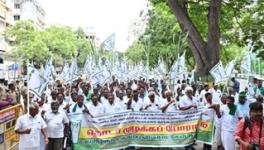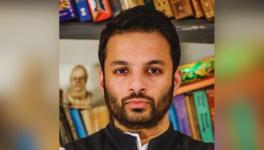“The Pandemic Reminds Us That Artists are the Conscience-keepers of Society”
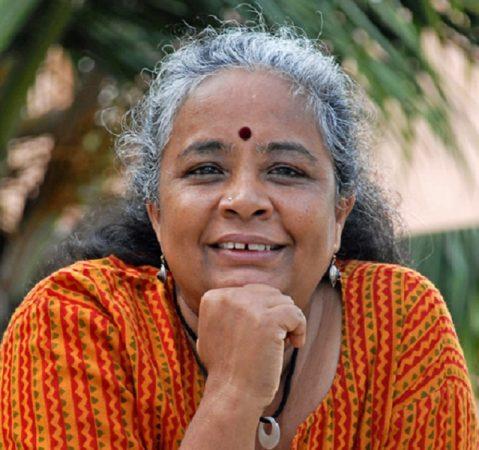
A. Mangai at Chennai | N. Sridhar
A Mangai is the pen name of Padma Venkataraman, who has been active in Tamil theatre as an actor, director and researcher for almost three decades. Known for her intensely political plays, Mangai has taken up popular female figures from both mythology and history, and interpreted them as women with strong voices of their own. Mangai's journey with political theatre began somewhere around the 1980s, when she, along with others, founded the Chennai Kalai Kuzhu, a left-wing theatre group as part of her involvement with the All India Democratic Women's Association (AIDWA). An academician and a former professor of English, Mangai has also researched extensively on Tamil theatre. Her latest book, Acting Up: Gender and Theatre in India, 1979 Onwards, was published by Leftword in 2015.
In this interview with the Indian Cultural Forum, Mangai shares her earliest memories of performance, what feminist theatre means to her, Tamil nationalism, and much more.
Indian Cultural Forum (ICF): What are your early memories of performance and performers? How did you come to theatre as your means of creative expression?
A. Mangai (AM): Over the years, I have been exposed to very different aspects of performance, as well as the world – or should I say worlds – of performers. I grew up in Nagapattinam, a seaside town of historical importance. I grew up with my grandparents, and I remember accompanying my grandmother to many Kathakaletshepams in different temples. Most of the performers sat as if they were singing in a musical concert and performed. I vaguely remember a woman performer who stood up, sang and moved rhythmically with the chapla kattai once. The other memory I have is different: a performer from the nomadic boom boom maatukkarar community with his decorated bull came to our doorstep but he was not allowed to play his drum there long. Such was the conservative Brahminism I was born into.
I joined the Besant Theosophical High School, attached to Kalakshetra in Chennai at the age of eleven as a scholarship student. I was a residential student. Rukmini Devi – Aththai (Aunt, meant generically here), as we called her, was quite active then. I was a volunteer in all the art festivals there. That way I could watch the performances for free. I also had opportunities to watch Aththai at rehearsal. She once cast me as Bharata in the play Shakuntala. I could not pick up the ten Sanskrit sentences at that time and was dropped. I also learnt Bharatanatyam as a part-time student for two years. I realise now that much of my disciplined attitude to theatre comes from that time. In college, the usual engagement with theatre as an extra-curricular activity continued.
My life changed once I fought a personal battle to choose my partner. The adventure went beyond the personal though. The progressive outlook is what linked our involvement in literature, theatre, as well as movements for change. In 1984, as part of the Progressive Writers’ Association, which was a cultural organisation of the CPI(M), we founded the Chennai Kalai Kuzhu, a theatre group with left allegiance. Pralayan, a major street theatre activist of Tamil Nadu, continues to lead it. Around the same time, we also formed the Sakthi Kalai Kuzhu as part of AIDWA (All India Democratic Women’s Association), Chennai. We also formed the Palkalai Arangam at the University with the majority of members from the Department of Tamil Literature, University of Madras, where Arasu, my husband, was teaching. I was doing my research in the Department of English then. It was also part of the Progressive Writers Association. ‘Pal kalai’ meant ‘different art forms’ and was also a short term for University. I was active in both the Writers’ association and Women’s movement. It was also when my Palkalai Arangam started working with Elaya. Pathmanaathan (a Sri Lankan Tamil theatre person in exile in Tamil Nadu at the time), who became my mentor in theatre. The collectivism and group dynamics in theatre so captivated me that I consciously withdrew from other forms like oratory.
Also Read: Artists and Performers in the Time of Covid-19 – Part Two
In 1990, I attended "Expressions", a women’s theatre festival organised by Majlis in Bombay. That was, I now realise, a turning point: I knew theatre was my genre. At "Expressions", my politics of gender and theatre came together. Theatre made it possible to accommodate multiple voices, attitudes and imaginations. When I wanted to form a theatre space where women can occupy 50% of the stage and work towards a theatre for women’s expressions, "Voicing Silence" was formed. It was started as a project at M.S. Swaminathan Research Foundation in 1992. Mina Swaminathan gave shape to that dream. She had recently moved from Delhi after her work in early education and child care. Mina had been using theatre in her work in Delhi as well. We have been fellow travellers since then. What we share is uniquely intergenerational, critical while being creative.
ICF: You have also done a great deal of research over the years. Tell us about some features unique to Tamil theatre?
AM: Initially, I gathered material on the performing arts of Tamil Nadu. My friend V. R. Devika, who was working at the Madras Craft Foundation, organised events to introduce the traditional art forms to Chennai schools. She was a trained classical dancer and deeply involved in arts education. I helped with translation and documentation of the artists and their art forms. That journey was most rewarding. Also, the 1980s covered an important period in modern Tamil theatre. There were heated debates on the form, training, funding and themes/ texts chosen for performances. Since I was also a student of literature, I could read the discussions taking place in little magazines in Tamil. I soon realised that there was so little about Tamil theatre in English. For a long time, we had a few Delhi-based Tamil writers who contributed to discussions on Tamil literature and culture in English; for instance, Ka Naa Subramaniam, Venkat Swaminathan. They were partisan in their choices and the result was that the information in English about Tamil was inadequate. So, I got into it. I am a reluctant researcher. But I am glad I did it, and I am glad I still do it. But the accountability of a bilingual scholar is greater.
As for the distinguishing features of theatre in Tamil Nadu: it does have a different trajectory from the other South Indian states as well. With regard to modernising forms, as in the case of Yaksha Gana by Shivram Karanth, Tamil Nadu did not have anyone engaging (or meddling) with traditional forms. Krishnaiyar and Rukmini Devi had their hands full with making sadir into Bharatanatyam. The connection between caste and folk forms was always critiqued in Tamil Nadu from the early 20th century. Therefore, the recourse to folk forms as an expression of pre-colonial times never caught the imagination in Tamil Nadu. In fact, as Theodore Baskaran’s The Message Bearers establishes, it was the early modern "special drama" or Isai Natakam which rose to the occasion during the freedom struggle. These plays were mythological in content and musical in form. They soon adapted many "Parsi" theatre techniques. Like in other regions, these artists moved into silent cinema and later to Talkies as well.
Late 19th century and early 20th century saw the reinventing of ancient Tamil identity. Sangam corpus of classical Tamil literature helped establish the ancient nature of Tamil literature. The Tamil epics, Silappadhikaram and Manimekalai – interestingly, Jain and Buddhist – saw the light of publication. The establishment of comparative Dravidian grammar by Caldwell, Iyothee Dass’s Tamil Buddhism, Tamil Saivite scholars’ interest in Tamil antiquity, and archaeological evidences of proto form of Tamil script shaped a unique idea of "Tamil-ness" ushered in a passionate idea of Tamil identity. This momentum was effectively seized by the Dravidian movements. We find these sentiments flare up even today in the case of debates – say on the Keezhadi excavation or on the Indus script.
All other South Indian languages exhibited a relatively smooth accommodation with Sanskrit and were probably more open to dialects within. The impact of diglossia in Tamil still leaves a huge gap between the written language and the spoken language. Other South Indian languages did not face such drastic changes in their history of language, even though like all other languages, they also had shifts from the 14th century onwards.
This complex of language and identity echoed in drama and theatre, especially in the plays written and performed by the writers and artists of the Dravidian Movement. In fact, the Tamil Nadu based theatre groups travelled to Malaysia, erstwhile Burma, Sri Lanka, countries where there was a sizable Tamil population – indentured labourers, their supervisors and business people. This south and south-east Asian route was in place right from the early 20th century. Many popular theatre companies travelled to these countries.
Also Read: “Chughtai mastered the art of giving women a voice”
As far as Indian progressive movements are concerned, right from the IPTA era, Tamil Nadu’s response was lukewarm. We do have names of people attending IPTA meets in Sudhi Pradhan’s volumes. But on the ground, there was next to nothing. In my recent study on the cultural work of the Left in the 1940s in Tamil Nadu, I have found that the Communist Party took up this work directly. There were many street singers, for example, who took on topical issues such as Bengal Famine relief. The advent of the South Indian Welfare Association which later became the Justice Party in 1916; the rise of Periyar’s Dravidian Movement from1925 onward; and the involvement of the DMK (1949) leadership and workers in literature, drama and film – all these together created, almost, a parallel sub-regionalism in Tamil Nadu. This was much more visible in the language question, but it had its effect on drama and theatre as well.
Nationally, the second wave of Back to the Roots began as a state-sponsored agenda in the 1980s. Backed by foreign funds, especially that of the Ford Foundation, there were groups like Koothu Pattarai led by the late Na. Muthusami, a pioneer of Modern Tamil Theatre and an avant garde writer, taking up traditional folk forms. He was genuinely exploring koothu as a "total theatre form" of Tamil Nadu. He also worked closely with the doyen of Theru Koothu genre Purisai Kannappa Thambiran. Theatre in Tamil Nadu went on to engage with Tappattam (drum dance of dalits) and Devarattam (a ritualistic dance form of a Telugu settler community in Tamil Nadu), which have become the staple of modern theatre in Tamil from the late ‘70s and early 1980s. Karnataka and Kerala, probably, reached this phase earlier, during the nationalist struggle and IPTA era.
ICF: In your book, Acting Up: Gender and Theatre in India, 1979 Onwards (Leftword, 2015), you talk of how the mainstream imagination of the "national" kept women’s theatre and groups like the IPTA out of it, during the freedom movement. Could you tell us about that?
AM: Thank you for this question. The Nehruvian government attempted to build a cultural imagination of the Indian nation – the national cultural identity – in the mid-50s. The Sangeet Natak Akademi organised four seminars between 1955 – 1958 to envision a national culture. The seminars were on film (1955), drama (1956), music (1957), and dance (1958). I find the order of these subjects very telling. It tries to time-travel backwards from the modern genre of film to the most ancient form of dance. What is worse is that it took five decades for the reports from these seminars to see the light of day. Anita Cherian’s critical analysis is lucid in pointing out the silences in this official construction of national culture. She points out how the issue of diversity was addressed by the representation of each language or State. Sanskrit of course was considered superior to all languages and presented first as providing the "origin" of Indian theatre. Professor V. Ragavan from Chennai spoke on Sanskrit theatre; his lecture was the first one in the seminar. In fact, except Sanskrit, all other languages were presented in alphabetical order in the drama seminar!
The other two, underrepresented in official narratives but profoundly significant, trajectories were that of Parsi theatre and IPTA. Parsi was for mass lay audiences and was hybrid, making it "inauthentic". However, the mass nationalist and reformist appeal of Parsi theatre did not go unreported. The omission of IPTA was much more glaring. Of course, participants of the seminar referred to personal anecdotes of IPTA. The 1956 Drama seminar focussed on creating a "native" tradition of theatre by taking recourse to classical and folk forms of the country, which was exactly what IPTA attempted and succeeded. The only reason to have avoided the rightful place to IPTA must, then, be its allegiance to left and progressive ideology. As more studies on IPTA emerge – I must mention Sumangala Damodaran’s Radical Impulse and Ania Loomba’s Revolutionary Desires – the Nehruvian regime’s mask of socialism slips entirely.
These omissions had a ripple effect on the relative "invisibilisation" of women’s participation in theatre as well. Hence the 1989 National Theatre Festival of Nehru Shatabdi Natya Samorah became a representation of "Indian" theatre officially. No wonder scholars like Aparna Dharwadkar saw it as epitomising Indian National theatre. But by that time, we had a decade of concerted efforts on women’s theatre/ feminist theatre all over the nation. But, academicians and fellow-colleagues in theatre did not take into account the new trend in theatre made possible by the women’s movements. Even as late as in 2004, Ananda Lal’s first edition of The Oxford Companion to Indian Drama did not mention women’s theatre / feminist theatre, even though he had included many female artists. In 2009, when he brought out Theatres of India, a chapter was devoted to feminist theatre.
There seems to be a lack of a conscious understanding of gender, and a critique of male privilege still. What is heartening is that women with varied levels of feminist consciousness and queer activists continue their path-breaking work. After all, theatre lives in the "present".
ICF: You say feminist theatre can be distinguished from other kinds of theatre in terms of content and form. Could you explain the significance of form in progressive theatre and how it is different in "feminist theatre"? Historically, what are some of the changes feminist theatre form has gone through over the years?
AM: Like all other theatre, feminist theatre is also not "unique". It draws from various existing aspects of theatre in general, and progressive theatre in particular. Bertolt Brecht and Augusto Boal are equally valuable to feminist theatre too. The distinctive aspect of feminist theatre is, probably, its commitment to a non-hierarchical approach to the process of making theatre. This makes long-term collaborative processes possible. The collectivism experienced in feminist theatre is not based on a common "goal", or a stated shared ideological understanding as in most other forms of progressive theatre. It emanates, in essence, from a sense of nurture and care in the face of differences. I do not wish to romanticise this process by any means. But an attempt to hold on to it as the essence of feminist theatre is certainly present in practitioners of feminist theatre. I wish other progressive theatres would also imbibe this!
Also Read: Artists and Performers in the Time of Covid-19 — Part One
The theatrical interventions by feminist theatres in terms of time (rehearsals, shows, audience convenience), space (literally and figuratively on and off stage), visualisation, depiction of assertive sexuality and many others, stem from questioning authority – both with benign intentions and outright condemnation. I learnt that our shows have to be at a convenient time for women to assemble. So, we had matinee shows. In fact, Kaala Kanavu, a play on the history of feminist thought in Tamil Nadu by the feminist historian V. Geetha, opened at 4 pm at Queen Mary’s College. We had women from all the women’s movements present at that performance. Has any other play had a kitchen on stage like Neelam’s Kitchen Katha? The response of women directors to the spread of communalisation in the country has been significant with the revival of Manto, the retelling of partition stories, and remembering the contribution of Muslims to the country and many such. I remember the durational reading of Krishna Sobti’s epic novel Dil-o-Danish on the lawns of a house in Jamia Nagar, directed by Anuradha Kapur. An immersive experience of having dhurries, shawls and blankets to combat the December winter and food was soothing to the soul. Not to mention how Maya Rao responds to events around her. Her audio and video texts during the Covid-19 pandemic reminds us that artists are the conscience keepers of the society. In short, unlike most other progressive theatre practices, it is difficult to set an agenda in feminist theatre/s. I think these two theatrical trajectories overlap and contribute to each other in complex ways. As in all intimacies, there are constant negotiations.
ICF: What lessons from Tamil nationalism can we recall now, when the ruling dispensation is pushing homogenisation?
AM: I know that a few right-wing online campaigns used a truncated clip from my lecture in the JNU Nationalism lecture series. In my lecture, I shared my critique of Dravidian movements in the post-Periyarist phase from a play called Aanmaiyo Aanmai written by V. Geetha and directed by me. The reference was to a wall writing of the DMK electoral campaign: "When you have your cousin (Athai Magal) Tamil; and English, the desirable 'kept-woman'; where is the need for that whore Hindi?" How can one justify such parochial feudalism? BUT – language, culture, governance are the rights of all citizens. To impose any kind of homogenisation will only touch a raw nerve. Tamil Nationalism has had a long history, dating back to well before the freedom struggle. There have been three linguistic wars in Tamil Nadu: in 1938, in 1952-54, and in 1965. We are still fighting the imposition of Hindi. And all these struggles have included socially marginalised groups in terms of caste and religion. So, the progressive aspects of Tamil nationalism are social justice and gender reforms. Those aspects offer the country important lessons in federalism and decentralisation.
During my recent visit to Delhi, when the anti-CAA protests were going on, I shared a quote from a song made popular by Nagoor Hanifa:
Inthiya engal Thainaadu / Islam engal vazhibaadu
Tamizhe engal mozhiyaagum / Thanmaanam engal uyiraagum
"India is our motherland; /Islam is our worship;
Tamil is our language; /Self- respect is our life".
Nagoor Hanifa was a life-time supporter of DMK till his death in 2015. This song, which he sang from the '70s, assumed even more significance during the anti-CAA struggles. It is deeply disconcerting to see the federal structure of India being tossed around. The arrogance and impunity with which the present government imposes its policies, whether on language, education, textbooks or, indeed, the status of J&K, all challenge democracy.
Get the latest reports & analysis with people's perspective on Protests, movements & deep analytical videos, discussions of the current affairs in your Telegram app. Subscribe to NewsClick's Telegram channel & get Real-Time updates on stories, as they get published on our website.









